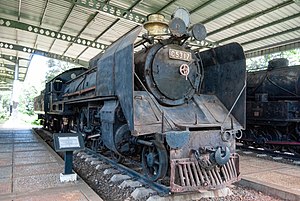| Revision as of 20:40, 21 December 2024 editYugystudios (talk | contribs)241 edits external links with locomotive magazine article via google books for potentially useful information← Previous edit | Revision as of 20:41, 21 December 2024 edit undoYugystudios (talk | contribs)241 edits →External links: commonscatNext edit → | ||
| Line 61: | Line 61: | ||
| == External links == | == External links == | ||
| {{Commons category|Indonesian SS1000 (C53) class}} | |||
| * of the 1000/C53 class locomotives in ] magazine by the ], pgs. 176-181 and 200-203 on ] | * of the 1000/C53 class locomotives in ] magazine by the ], pgs. 176-181 and 200-203 on ] | ||
Revision as of 20:41, 21 December 2024
| SS 1000 class (later C53 class) | |||||||||||||||||||||||||||||||||||||||
|---|---|---|---|---|---|---|---|---|---|---|---|---|---|---|---|---|---|---|---|---|---|---|---|---|---|---|---|---|---|---|---|---|---|---|---|---|---|---|---|
 C53 17 at the Transportation Museum in Taman Mini Indonesia Indah (TMII). C53 17 at the Transportation Museum in Taman Mini Indonesia Indah (TMII). | |||||||||||||||||||||||||||||||||||||||
| |||||||||||||||||||||||||||||||||||||||
| |||||||||||||||||||||||||||||||||||||||
| |||||||||||||||||||||||||||||||||||||||
| |||||||||||||||||||||||||||||||||||||||
The SS 1000 class, later reclassified as the C53 class, are a class of 20 4-6-2 four-cylinder passenger steam locomotives built by Werkspoor in the Netherlands for the railways of the Dutch East Indies. It measured 20,792 mm in length, has a power rating of 1,200 hp, weighs 109.19 tons, and has a top speed of 90 km/h. They were initially numbered SS 1001-1020. The class are known for being a successful locomotive class, but are also known for being problematic in operation.
Design and operational history
During the Dutch colonial administration, nighttime passenger train services were considered unsafe because of the concern by the Dutch about natural threats in the tropical environment; consequently, trains had to stop midway for the night before resuming their journey after dawn. The distance between Jakarta and Surabaya was around 820 km and powerful locomotives were needed to complete the rail journey before sunset.

Therefore, the SS 1000 class were built by Werkspoor in the Netherlands between 1918 and 1922 in a batch of 20 locomotives. They were used on express trains such as the Eendaagsche Express and the Nacht Express, which first ran on November 1, 1929 and November 1, 1936 respectively. The travel time of the Eendaagsche Express, when introduced, was 13 hours and 30 minutes, which was later shortened to 11 hours and 27 minutes in 1939.
Werkspoor designed the locomotives as four-cylinder compound locomotives as a way to bolster the Staatsspoorwegen's fleet. During testing, problems were discovered that affected the performance of the class, as Werkspoor was inexperienced at building four-cylinder compound locomotives. Ten years after being introduced, smoke deflectors were fitted to the 1000 class to drift smoke away so as to not to obscure the driver's vision.
The four-cylinder compound arrangement was expected to provide the locomotive stability when running at high speeds, but its performance was less than satisfactory, being prone to rough riding at speeds of 90 km/h. In 1931, the 1000s shook violently while running at 100 km/h. Despite the high maintenance and operating costs, the Staatsspoorwegen retained these locomotives for its express trains, cutting journey times between Jakarta and Surabaya from 29 hours to 12 hours and 20 minutes. The average speed between the two cities was now 75.8 km/h, with trains even topping up 120 km/h in operation. During the Japanese occupation of the Dutch East Indies, the 1000 class were redesignated as the C53 class.
By the 1970s, the C53s, most of which were allocated to Sidotopo depot, were relegated to local passenger and freight services, having been replaced by diesel locomotives. Only one locomotive, C53 17, has been preserved and is on display at Taman Mini Indonesia Indah's Transportation Museum.
Gallery
References
- "Steam Locomotive Roster, Page 1". keretapi.tripod.com. Retrieved 14 December 2024.
- ^ Hollingsworth, J.B. (1982). The Illustrated Encyclopedia of the World's Steam Passenger Locomotives. Crescent Books. p. 102. ISBN 9780517374863.
- Bagus Prayogo, Yoga; Yohanes Sapto, Prabowo; Radityo, Diaz (2017). Kereta Api di Indonesia. Sejarah Lokomotif di Indonesia. Yogyakarta: Jogja Bangkit Publisher. p. 88. ISBN 978-602-0818-55-9.
- "C28 dan C53, Loko Uap Tercepat di Indonesia" [C28 and C53, The Fastest Steam Locos in Indonesia]. kereta-api.info (in Indonesian). Archived from the original on 2 December 2021. Retrieved 14 December 2024.
- ^ "Locomotive C53". heritage.kereta-api.co.id (in Indonesian). Archived from the original on 15 April 2023. Retrieved 14 December 2024.
- Ziel, Ron; Eagleson, Mike (1973). The Twilight of World Steam. Madison Square Press. p. 211. ISBN 9780448024325.
External links
- Article on and diagrams of the 1000/C53 class locomotives in The Locomotive magazine by the Locomotive Publishing Company, pgs. 176-181 and 200-203 on Google Books
